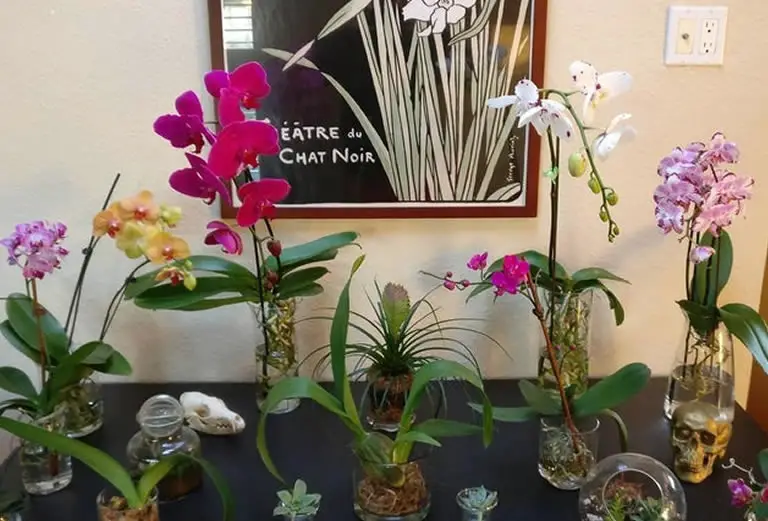You may have many houseplants that are near and dear to your heart, but if you are like a large number of other Americans then your favorite could well be the orchid. After a long period of care you’ve been waiting patiently for the plant to finally bloom.
Table of Contents
- How long orchids bloom on average
- How long you can expect orchid blooms to last depends on the species
- How often orchids bloom
- How long orchid blooms last on average
- 5 Steps to make orchid blooms last longer
- How long orchids live on average
- Summary: How Long Orchid Blooms Last & How To Make Them Last Longer
How long orchids bloom on average
How long do orchids last once they’ve bloomed and once your plant produces those long-awaited flowers is there any way to extend the orchid’s blooming period?
There are many different species of orchids that have blooms that can last from 1 week to 16 weeks.
On average though orchids will normally bloom between 6 – 8 weeks.
There are specific orchid care requirements for making orchid blooms last longer.
These include maintaining the correct humidity and light levels as well as ensuring the correct temperatures are observed. Watering and fertilizing requirements most also be met.
Whether you’re on the cusp of witnessing your orchid bloom for the first time or it’s done so once already and you’re eager for it to happen again, this article is for you.
Ahead, we’ll talk about the orchid blooming period, how many times per year an orchid blooms, how to see beautiful flowers more often and how to make those flowers last longer.
How long you can expect orchid blooms to last depends on the species
When we say orchid, we’re referring to one of up to 28,000 unique species (botanical name, Orchidaceae).
So, with so many species out there, it should come as no surprise that not every single orchid species is going to bloom in the same way.
Although they are not technically succulents, many orchid species share some of the same characteristics of succulents. They are resilient plants that are able to survive low-light conditions and can handle drought fairly well.
While not all orchids should be cared for in the same way you would succulents, there are some epiphytic orchids that definitely should be.
These orchids have embraced a life very similar to that of a succulent, leaving some people with the misconception that orchids are succulents. They are not.
So, when it comes to creating a care routine of your specific plant you should first clearly identify what species of orchid you have.
Only then will you be able to care for the plant correctly.
Here is a timeline for how long your specific orchid may bloom based on the most common species grown as houseplants.
How long Dendrobium flowers last
The Dendrobium orchid genus includes 1,800 species (and counting as more hybrids are cultivated).
This genus of orchid is native to southeast, east, and south Asia, and some islands in the Pacific.
Some parts of the world where Dendrobium thrive naturally are Vietnam, New Guinea, Australia, Indonesia, the Philippines, India, Japan, and China.

Dendrobium orchids develop roots that can grow over rocks or trees rather than develop in the soil similar to some desert succulents.
Each unbranched stem can sprout many flowers, which come in hues such as purple, pink, yellow, green, or white.
The flowers usually feature contrasting hues as well making this a very aesthetically pleasing plant.
The lifespan of Dendrobium orchid flowers can last as little as 6 weeks or up to 12 weeks with proper care and attention.
How long Phalaenopsis flowers last
Moth orchids or Phalaenopsis is a genus with nearly 70 unique orchid species.
Like Dendrobium orchids, moth orchids grow natively in Australia, New Guinea, Southeast Asia, China, Taiwan, and India.
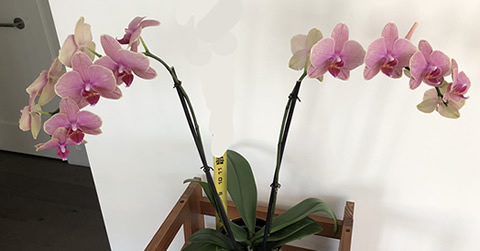
The roots of a Phalaenopsis orchid are coarse and lengthy.
The flowers that grow from the short stems are flat yet appealing.
The smell of the flowers is also utterly delectable. Insects seem to think so too. These flowers attract butterflies and helping the endangered bee population, though this mostly only noticeable with outdoor plants.
The lifespan of Phalaenopsis flowers is 8 to 16 weeks, making them the longest bloom lifespan of all orchid species.
If you want exceptionally long orchid blooms then Phalaenopsis is the plant to grow.
How long Paphiopedilum flowers last
The Venus slipper or Paphiopedilum is a genus of orchid with over 90 different species.
This special orchid grows across the Bismarck Islands, the Solomon Islands, New Guinea, southern China, the Indian Subcontinent, and Southeast Asia.
Unfortunately, Venus slippers are quite rare. Their beauty and inimitability make them prone to poaching.
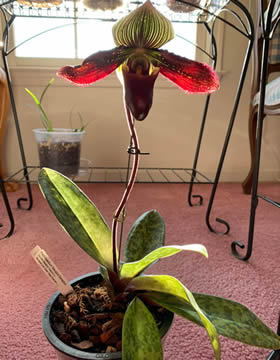
If you own a Paphiopedilum, the flower shape is very different compared to other orchid species.
The plant has evolved to utilizes an insect’s ability’s to help with pollination by using a very clever tactic.
The labellum features a distinct pouch that can entrap insects for a short period.
Once trapped the insects can then only exit from the staminode, being forced to leave behind their pollen as they do so.
Paphiopedilum orchids will bloom for 6 to 8 weeks, which is quite a long time to enjoy the flowers on this indoor plant.
How long Oncidium flowers last
If your orchid is an Oncidium or Onc., then it’s one of 330 species that grow natively in Florida, the West Indies, Mexico, Central America, and South America.
Known as the golden shower orchid or the dancing-lady orchid, the Oncidium produces tiny flowers on its racemes.
A raceme is an unbranched inflorescence that grows on the pseudobulbs of Oncidium orchids.
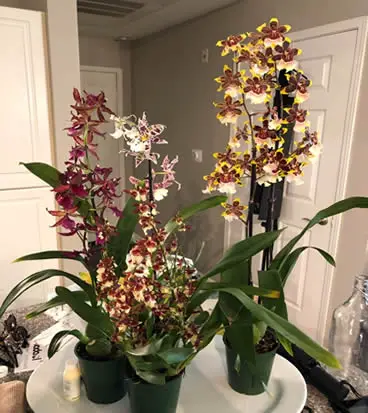
The flowers might not be the most appealing of the many orchids available. The hue is brownish, yellowish, or reddish, but it is still a popular houseplant as it gives contrast to other orchids and flowering houseplants.
A few species do grow prettier flowers in colors like pink or white with traces of red though it is less common to see these in homes.
Oncidium orchids bloom for 4 to 6 weeks.
How long Cattleya flowers last
Finally, we have the Cattleya orchids, which grow between Argentina and Costa Rica.
The flowers of a Cattleya orchid are much beloved due to the difference in shape and coloration from the labellum, or flower lip, to the lower half of the flower.
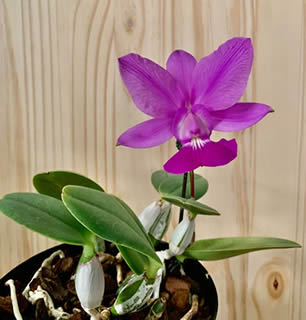
Unfortunately, you get the least amount of time to enjoy these species of orchids, as Cattleya bloom for 1 to 3 weeks only.
It is worth having one in your home though especially if you grow it with another orchid genus.
How often orchids bloom
Now that you’re aware of how long you can enjoy the beauty of various orchid species when they flower, your next question will probably be, how often do orchids bloom?
Orchids are perennials.
So, at the very least, you should expect your orchids to bloom annually.
Do you see flowers more than once per year? You should be proud of yourself as you have been giving your plant the ideal care it requires.
You see, a happy orchid can bloom two or even more times per year.
So, if you want your orchid to bloom more than once in a 12 month period you must get its care routine correct (more on this later).
The times of year in which you’re most likely to see the beautiful blooms on an orchid will vary by species.
However, for many common houseplant orchid species, blooms come to life in late winter or in early spring – between January and March.
Other common orchid houseplant species will bloom in the autumn from September onward to just prior to early winter.
How long orchid blooms last on average
So how long do orchid blooms last before the flower die and fall away from the plant?
On average orchids blooms will last from 6 – 8 weeks.
Some orchid blooms last for just one week (such as Cattleya) while others can last several months (such as Phalaenopsis).
There are specific care steps you can take to make indoor orchids last much longer.
First identify the exact orchid species and then adjust your care routine appropriately.
For the correct care routine for your specific orchid species see the sections above.
Let’s take a look at five simple steps you can take to make your orchid blooms last longer no matter which species of orchid you own.
5 Steps to make orchid blooms last longer
Below are 5 simple steps to make your orchid blooms last longer.
5 steps to longer orchid blooms
There are five key care requirements you must observe if you want to lengthen the life of your orchid blooms.
5 steps to make orchid blooms last longer:
- Identify your species of orchid.
- Regulate the temperature.
- Ensure the plant gets the correct light.
- Maintain correct humidity levels.
- Observe the correct correct watering schedule.
Let’s take a quick look at these five key care steps in a little more detail.
1. Identify your species of orchid
In order to give your orchid the correct care you must know which type of orchid you have (see sections above).
There is much variety of orchids on the market with some species requiring a similar approach to succulent care while others would not respond well to that approach.
Each species has its own requirements.
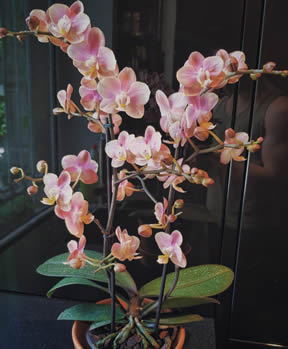
Ensuring you create the ideal conditions for your species of orchid will result in better blooms and flowers that live longer.
So, be sure you know which type of orchid you own before you start using generic orchid care advice on your plant.
You can easily identify your own species by matching it to the images given above in this article or by researching online and matching your plant to images of orchid plants.
If you bought your orchid from a reputable vendor then the plant will have been clearly identified upon purchase. If it was not then simply contact the seller and ask them what type of orchid they sold you.
Ensuring you are using the correct care routine for your specific orchid species will translate into more vibrant and longer-lasting blooms as well as ensuring you have a healthier plant overall.
2. Set the correct temperature
Although each species of orchid is slightly different, generally speaking orchids prefer intermediate temperatures.
Orchids will thrive in daylight temperatures of around 75°F or slightly more, and night temperatures of around 65°F or slightly more.
As US households are generally kept within a consistent 68°F – 76°F temperature range, with the average being 70°F, this means orchids make an ideal houseplant.
The key to keeping orchid blooms last longer, as far as temperature goes, is to maintain a consistent ideal temperature range.
Orchids will keep their blooms much longer if they are not exposed to very high or cold temperatures – especially if temperatures fluctuate between the two extremes.
Both hot and cold blasts of air (from being placed near opening refrigerator/freezer doors or radiators/heater vents, for example) can make orchid buds drop off the plant while also drying out open flowers.
Constant drafts will also have the same devastating effects on the plant blooms.
It is therefore best to place your orchid in a location that has a fairly consistent room temperature.
Never put your plant beside a fridge, a freezer or an outside opening door or in any other area that gets drafts or fluctuations in temperature.
3. Give the plant the correct light
Bright filtered light will be favorable for most common houseplant orchids available for purchase.
This means giving your plant very good strong indirect light.

Orchids require between 12 – 14 hours of indirect light each day.
Insufficient light will lead to a reduction in flower lifespan, if the plant even blooms at all.
For new orchid owners it can be difficult to get the light correct initially.
With orchids its all about location, location, location!
If orchids get too little light, by being placed in a gloomy or not-very-well-lit area, the lack of light will restrict the photosynthesis process causing leaves to lose their luster.
Flowers will be sickly- looking and have no vibrancy.
The plant may not even bloom at all.
Strong direct sunlight is equally bad for orchids though.
Direct sunlight can burn both flowers and leaves and dehydrate the plant quickly leading to, not only a lack of moisture but also, a lack of nutrients getting to the foliage.
So, it is best to place your orchid in an area close to a bright window, but not so close the plant gets hit with strong direct UV light, or in a room that has plenty of natural light.
If you find it difficult to find the ideal place to put your orchid i.e. somewhere where it will get sufficient amounts of indirect light, you can use a small grow light.
A grow light will give the plant the additional light it needs.
This is a much better option than moving the plant to a location with only direct sunlight.
A small grow light is also very helpful for an orchid in the winter months when daylight hours are shorter.
4. Ensure the plant has the correct humidity
Although many orchids share very similar characteristics to succulents, most orchids like the same type of humidity levels as human beings, unlike succulents.
This makes them great houseplants.
Human beings feel comfortable with humidity levels that fall between 40% – 60%.
Orchids like humidity levels that fall somewhere between 40% – 70%.
On average a US home will have humidity levels that fall between the 30% – 60%.
Typically humidity levels will fall between 50 % – 55% in a typical summer and between 45% – 50% during a normal winter, thus winter making most US homes ideal for growing orchids.
If you live in a home that normally falls into the lower range, and has low humidity levels below 40%, you can always increase the humidity directly around your plant. You can do this by using a water mister daily though I much prefer to simply pot the plant in a terracotta pot (see why this works so well here).
5. Observe the correct watering schedule
As I mentioned earlier, although they are not technically succulents, many orchids require similar care to succulents.
This is very much the case when it comes to watering an orchid. By far the most important aspect of any care routine for your orchid is the plant’s watering!
You must follow the correct watering routine for your orchid or you will risk damaging the plant.
Overwatering will suffocate the root system of the orchid and lead to root rot. See our article on the damaging effects of aloe vera root rot and the care required to save the plant, as overwatering an orchid will lead to the same problems and challenges.
On the flip side, insufficient watering will desiccate roots and dehydrate the plant.
Water is not only required to hydrate the plant but it also acts as a vehicle for disseminating nutrients to the foliage and buds.
Without sufficient water the plant will be unable to produce flowers while the plant’s leaves will lose color and luster.
Each species of orchid requires its own watering routine but on average an orchid will need to be watered once per week.
Water it from the bottom. Leave the potted plant in a basin or sink of water for about 20 minutes only.
Water your orchid in the morning. Never water at night.
If you want to get the most out of your plant and ensure it produces blooms that last as long as possible then be sure to check the guidelines for your specific orchid species. Do this before embarking on a set watering routine.
How long orchids live on average
Having a houseplant that only lasts one or two seasons is no good to anyone, especially if you have lavished your care ad attention on the plant.
You may be wondering if it is worthwhile to get an orchid for your home if it won’t last long. so, how long do orchids live on average?
A well cared for orchid can live for up to 20 years.
However, the average lifespan of a well cared for an indoor orchid is between 10 – 15 years.
If you give your orchid the proper care it needs then you can expect to see yearly flowers on your plant and flowers that are vibrant and long-lasting.
Summary: How Long Orchid Blooms Last & How To Make Them Last Longer
Most orchids, while not technically succulents, require similar care to succulents and they will bloom in similar ways.
Orchids can bloom for as little as one week or up to sixteen weeks (which is almost four months) depending on the species and the care the plant is given.
You’re likely to see orchids bloom at least once annually, but more frequent blooming can occur if you care well for your plant and it is growing in an ideal environment.
To make orchid blooms last longer be sure to first identify your specific species of orchid before creating an ideal care routine based on that species specific needs.
There is exactly great news for orchid owners, even those who grow the 1 week blooming Cattleya, in that you can take some simple steps to make any orchid rebloom.
Read our detailed instructions in the article how to make orchids rebloom.

